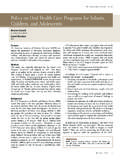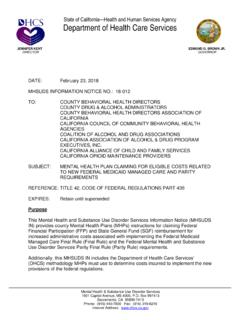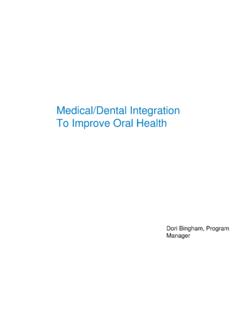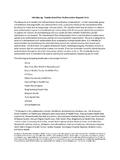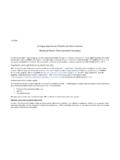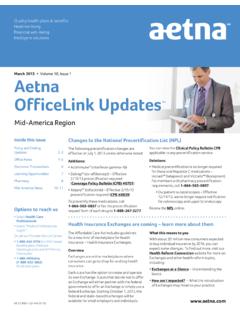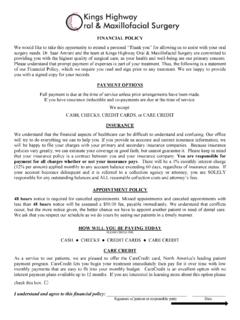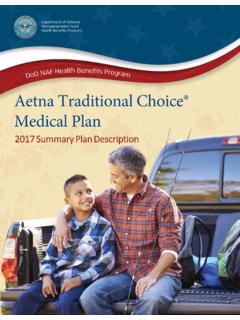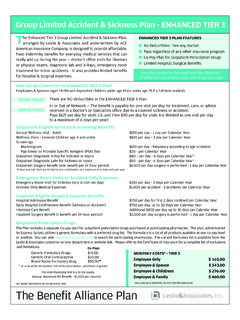Transcription of S Policy on Medically-Necessary Care - Pediatric …
1 REFERENCE MANUAL V 39 / NO 6 17 / 18. Policy on Medically-Necessary care Review Council Council on Clinical Affairs Latest Revision 2015. Purpose MNC increases the probability of good health and well- The American Academy of Pediatric Dentistry (AAPD) recog- being and decreases the likelihood of an unfavorable outcome. nizes that dental care is Medically-Necessary for the purpose Value of services is an important consideration, and all of preventing and eliminating orofacial disease, infection, and stakeholders should recognize that cost-effective care is not pain, restoring the form and function of the dentition, and necessarily the least expensive correcting facial disfiguration or dysfunction. Dental care is Medically-Necessary to prevent and elimi- nate orofacial disease, infection, and pain, to restore the form Methods and function of the dentition, and to correct facial disfig- This document was originally developed by the Council on uration or dysfunction.
2 Following the Surgeon General's Clinical Affairs and adopted in 2007. This document is an report 3 emphasizing that oral health is integral to general update from the last revision in 2014. It includes an elec- health , the Department of health and Human Services . tronic search with Scopus and PubMed /MEDLINE using the terms: Medically-Necessary care , systemic disease and oral recommended changing perceptions of the public, Policy makers, and healthcare providers so that oral health becomes disease, dentistry as Medically-Necessary care , periodontal di- an accepted component of general health . 4,5 oral diseases sease and cardiovascular disease, oral health and pregnancy, oral can have a direct and devastating impact on overall health , health and respiratory illness, Pediatric dentistry general especially for those with certain systemic health problems or anesthesia, and nutritional deficiency cognitive development; conditions.
3 Fields: all; limits: within the last 15 years, human, English. The Caries is the most common chronic disease of reviewers agreed upon the inclusion of 59 articles that met the Approximately 60 percent of children experience caries in defined criteria. When data did not appear sufficient or were their primary teeth by age five. 6 Between 1988-1994 and inconclusive, recommendations were based upon expert and/or 1999-2004, prevalence of caries in primary teeth increased for consensus opinion by experienced researchers and clinicians. youths aged two to 11 years, with a significant increase noted for those in the two to five year age range. 7 By 17 years of Background age, 78 percent of children in the have experienced car- The AAPD defines Medically-Necessary care (MNC) as the As much as 90 percent of all caries in school-aged children reasonable and essential diagnostic, preventive, and treatment occurs in pits and fissures.
4 Caries, periodontal diseases, and services (including supplies, appliances, and devices) and other oral conditions, if left untreated, can lead to pain, in- follow-up care as determined by qualified health care pro- fection, and loss of function. These undesirable outcomes can viders in treating any condition, disease, injury, or congenital adversely affect learning, communication, nutrition, and other or developmental malformation to promote optimal health , activities necessary for normal growth and development. 8. growth, and development. MNC includes all supportive health Rampant caries is associated with insufficient development in care services that, in the judgment of the attending dentist, children who have no other medical Children with are necessary for the provision of optimal quality therapeutic early childhood caries (ECC) may be severely underweight and preventive oral care .
5 These services include, but are not because of the associated pain and disinclination to eat. Nu- limited to, sedation, general anesthesia, and utilization of sur- tritional deficiencies during childhood can impact cognitive gical facilities. MNC must take into account the patient's age, developmental status, and psychosocial well-being, in addition Other oral conditions also can impact general health and to the clinical setting appropriate to meet the needs of the well-being. Gingivitis is nearly universal in children and adoles- patient and family. 1 cents, and children can develop severe forms of MNC is based upon current preventive and therapeutic practice guidelines formulated by professional organizations with recognized clinical expertise. Such recommendations ABBREVIATIONS. ideally are evidence based but, in the absence of conclusive AAPD: American Academy Pediatric Dentistry.
6 CC: Chronic condi- evidence, may rely on expert opinion and clinical observations. tion. ECC: Early childhood caries. MNC: Medically-Necessary care . Expected benefits of care should outweigh potential risks. 18 oral HE ALTH policies . AMERICAN ACADEMY OF Pediatric DENTISTRY. There exists a relationship between periodontal disease and primary and permanent An individualized pre- cardiovascular disease12,13 as well as periodontal disease and ventive plan based on a caries risk assessment is the key com- adverse pregnancy ,15 An association between oral ponent of caries prevention. Because any risk assessment tool health and respiratory diseases has been ,17 oral may fail to identify all infants at risk for developing ECC, health , oral microflora, and bacterial pneumonia, especially early establishment of the dental home is the ideal approach in populations at high risk for respiratory disease, have been for disease prevention.
7 31 Early diagnosis and timely inter- linked. The mouth can harbor respiratory pathogens that may vention, including necessary referrals, can prevent the need be aspirated, resulting in airway Problems of es- for more extensive and expensive care often required when thetics, form, and function can affect the developing psyche problems have gone unrecognized and/or of children, with life-long consequences in social, educational, When very young children have not been the benefici- and occupational Self-image, self-esteem, and aries of adequate preventive care and subsequently develop self-confidence are unavoidable issues in society, and an accept- ECC, therapeutic intervention should be provided by a prac- able orofacial presentation is a necessary component of these titioner with the training, experience, and expertise to manage psychological both the child and the disease process.
8 Because of the aggressive Congenital or acquired orofacial anomalies ( , ecto- nature of ECC, restorative treatment should be definitive yet dermal dysplasia, cleft defects, cysts, tumors) and malformed or specific for each individual patient. Conventional restorative missing teeth can have significant negative functional, esthetic, approaches may not arrest the Areas of deminerali- and psychological effects on individuals and their ,21 zation and hypoplasia can cavitate rapidly. The placement of Patients with craniofacial anomalies often require specialized stainless steel crowns may be necessary to decrease the number oral health care as a direct result of their craniofacial condition. of tooth surfaces at risk for new or secondary caries. Stainless These services are an integral part of the rehabilitative pro- steel crowns are less likely than other restorations to require Young children benefit from esthetic and functional re- ,35 Low levels of compliance with follow-up care storative or surgical techniques and readily adapt to appliances and a high recidivism rate of children requiring additional that replace missing teeth and improve function, appearance, treatment also can influence a practitioner's decisions for and self-image.
9 During the period of facial and oral growth, management of appliances require frequent adjustment and have to be remade Sealants are particularly effective in preventing pit and as the individual grows. fissure caries and providing cost savings if placed on the teeth Professional care is necessary to maintain oral health ,3,4 and of patients during periods of greatest risk. 37 Children with risk assessment is an integral element of contemporary preven- multiple risk factors and tooth morphology predisposed to tive care for infants, children, adolescents, and persons with plaque retention ( , developmental defects, pits and fissures). special health care The goal of caries risk assessment is benefit from having such teeth sealed prophylactically. A. to prevent disease by identifying and minimizing causative child who receives sealants is 72 percent less likely to receive factors ( , microbial burden, dietary habits, dental morphol- restorative services over the next three years than children ogy) and optimizing protective factors ( , fluoride exposure, who do Sealants placement on primary molars in young personal oral hygiene, sealants).
10 23,24 Ideally, risk assessment children is a cost-effective strategy for children at risk for and implementation of preventive strategies would occur caries, including those insured by state Medicaid programs. 39. before the disease process has been initiated. Although sealant retention rates initially are high, sealant loss Infants and young children have unique caries-risk factors does It is in the patient's interest to receive periodic such as ongoing establishment of oral flora and host defense evaluation of sealants. With follow-up care , the success rate of systems, susceptibility of newly erupted teeth, and development sealants may be 80 to 90 percent, even after a of dietary habits and childhood food preferences. Children Sealants are safe and effective, yet their use continues to be are most likely to develop caries if mutans streptococci is Initial insurance coverage for sealants often is denied, acquired at an early High-risk dietary practices appear and insurance coverage for repair and/or replacement may be to be established early, probably by 12 months of age, and ,42 While all Medicaid programs reimburse dentists are maintained throughout early Adolescence can for placement of sealants on permanent teeth, only one in be a time of heightened caries activity and periodontal disease three reimburses for primary molar While some due to an increased intake of cariogenic substances and inat- third party carriers restrict reimbursement for sealants to pa- tention to oral hygiene tients of certain ages.
